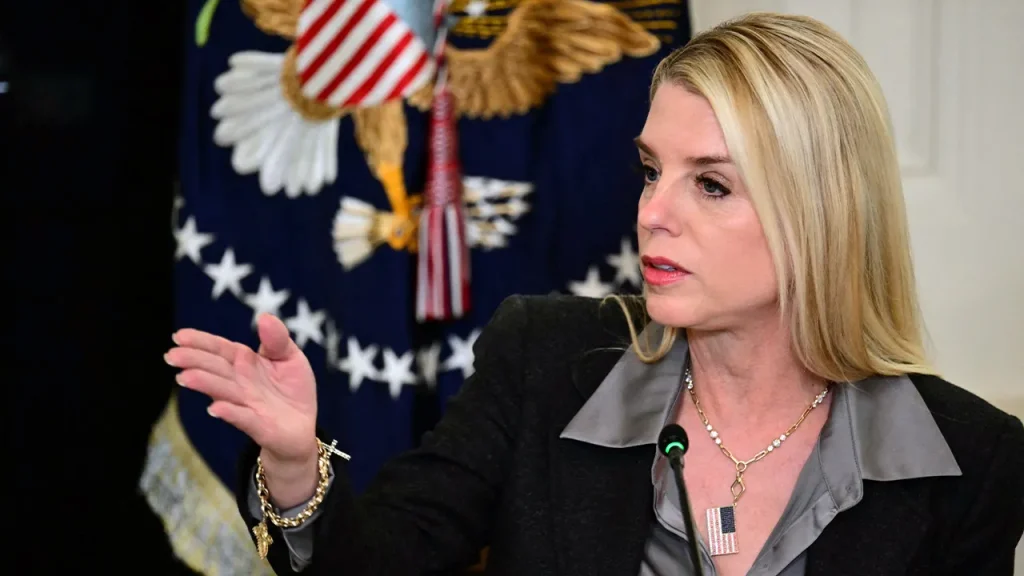Minnesota Man Faces Federal Charges for Alleged Bounty Threat Against AG Pam Bondi
A disturbing case has emerged from Minnesota, where a man with a history of violence is now facing serious federal charges after allegedly posting a threatening TikTok video targeting U.S. Attorney General Pam Bondi. The incident highlights the increasingly concerning intersection between social media, violent rhetoric, and real-world consequences in our digital age. Tyler Maxon Avalos reportedly posted an image of Bondi with an ominous red sniper-scope dot superimposed on her forehead, accompanied by a caption offering a $45,000 bounty for her capture “dead or alive”—though the post indicated a preference for “dead.” This wasn’t merely an offensive meme or tasteless joke; beneath the image, Avalos allegedly added the threatening message: “Cough cough. When they don’t serve us, then what?” The post quickly caught the attention of law enforcement after being reported by another TikTok user in Detroit, triggering an interstate FBI investigation that culminated in Avalos’s arrest at his St. Paul apartment.
The digital trail leading to Avalos was meticulously pieced together by federal investigators using data from multiple sources. The TikTok account “@liminalvoidslip” was connected to Avalos through records obtained from TikTok itself, along with information from Google and Comcast. What authorities discovered was particularly concerning given Avalos’s background. Court documents reveal that the 29-year-old has accumulated a pattern of violent offenses across two states. In 2022, he was convicted of felony stalking in Minnesota after repeatedly harassing a victim. Prior to that, in 2016, he had been convicted of third-degree felony domestic battery in Florida. That same year, he faced charges of felony domestic assault by strangulation in Minnesota, which were later reduced to a misdemeanor conviction. This history of escalating violent behavior added significant weight to the perceived threat contained in the social media post.
The FBI’s investigative work demonstrates the increasingly sophisticated methods law enforcement employs to track digital threats. Agents traced Avalos through a combination of digital footprints, including a Google-linked Samsung device, IP address logs, and subscriber data. This digital detective work led them to his physical address, where they confirmed his identity by checking the apartment mailbox. Beyond the threatening post itself, investigators noted that Avalos’s TikTok account displayed anarchist symbols and contained links to anti-government literature, including “An Anarchist FAQ book.” These additional details provided context for the threat, suggesting it wasn’t merely an isolated outburst but potentially connected to broader anti-government sentiments that had found a dangerous outlet in the specific threat against a high-ranking government official.
What sets this case apart from many social media controversies is how authorities are treating the threat. The FBI affidavit explicitly states that investigators don’t view the “murder-for-hire” post as a joke or hyperbolic political commentary. Instead, they consider it a deliberate interstate communication of violence—a serious federal crime. This perspective underscores how law enforcement agencies are increasingly treating violent online rhetoric with the same gravity as threats made in person, especially when targeted at public officials. The case comes at a time of heightened concern about political violence in America, with numerous public officials reporting an increase in threats and intimidation. The Justice Department has been increasingly vigilant about prosecuting such cases, viewing them as potential precursors to actual violence rather than mere online posturing.
The incident raises important questions about the responsibility of social media platforms in monitoring and reporting potentially dangerous content. The fact that the investigation began with a report from another TikTok user, rather than through the platform’s own content moderation systems, highlights the ongoing challenges tech companies face in policing violent content. While platforms have improved their ability to detect and remove certain types of harmful material, threats that use coded language or that are presented in novel ways can still slip through automated detection systems. This case demonstrates the vital role that human reporting still plays in identifying dangerous content online, even as artificial intelligence and other automated systems become more sophisticated. It also raises questions about whether platforms like TikTok should be doing more to proactively identify and report serious threats to law enforcement before they’re flagged by users.
The case against Avalos comes amid a broader national conversation about the boundaries of free speech, the responsibilities of social media companies, and the appropriate response to threatening rhetoric in polarized political times. While the First Amendment protects a wide range of expression, including harsh criticism of public officials, direct threats of violence have never enjoyed such protection. Federal prosecutors appear to be taking the position that Avalos’s post crossed the line from protected speech into criminal threat territory. As this case proceeds through the legal system, it will likely serve as yet another test case for how courts balance free expression against public safety in the digital era. For everyday Americans, the case serves as a stark reminder that online threats can lead to serious real-world consequences, including federal charges that carry significant penalties upon conviction. As our lives increasingly unfold in digital spaces, the line between virtual threats and real-world harm continues to blur, with law enforcement increasingly treating the former as a potential precursor to the latter.


